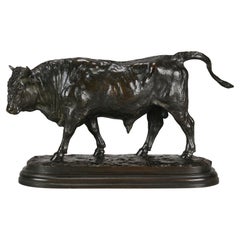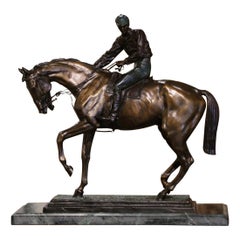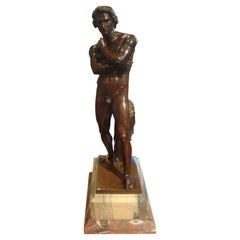Rosa Bonheur’s best-known artwork shows the horse market held in Paris on the tree-lined Boulevard de l’Hôpital, near the asylum of Salpêtrière, which is visible in the left background. For a year and a half Bonheur sketched there twice a week, dressing as a man to discourage attention. Bonheur was well established as an animal painter when the original painting debuted at the Paris Salon of 1853 where it received wide praise. In arriving at the final scheme, the artist drew inspiration from George Stubbs, Théodore Gericault, Eugène Delacroix, and ancient Greek sculpture: she referred to The Horse Fair as her own "Parthenon frieze."
Full Biography of Rosa Bonheur, b.1822 - 1899, French Painter and Sculptor
Childhood and Education
Rosa Bonheur (née Marie-Rosalie) was the oldest of four children, two girls and two boys, born to an idealistic artist father, Oscar-Raymond, and a patient piano teacher mother, Sophie. Interestingly, all four of the children grew to be talented and successful artists. The family moved from rural Bordeaux to Paris in 1829 when Rosa was six years old. She was a rambunctious child who enjoyed sketching as soon as she could hold a pencil, but initially struggled with reading and writing. Her mother helped her to learn basic literacy by asking her daughter to draw an animal for each letter of the alphabet. Rosa recalled ""...One day she had a bright idea...She told me to draw an ass opposite the A and a cow opposite the C and so on..."" Following her mother's ingenious method, Bonheur always credited her, and this moment in life for her enduring love and deep understanding of animals.
Life in the busy city of Paris was different from the calm country life of Bordeaux. Bonheur's father subscribed to the Saint-Simonian philosophy, which adhered to Utopian socialist values and supported a vision of universal harmony that included total sexual equality. Bonheur recalled ""...This was, I believe, the first pronounced step in a course which my father always pursued...named co-education...I was generally a leader in all the games...I did not hesitate now and again to use my fists...a masculine bent was given to my existence..."" Oscar-Raymond believed so resolutely in the education and equality of women that he became director for a time of the only available free drawing school for girls that had been founded in Paris under state sponsorship in 1803. After their father's death, Bonheur and one of her sisters took over his position as head of the school.
When Bonheur was only ten a cholera epidemic was sweeping through France. Her father was embroiled in his political and philosophical pursuits and her mother was exhausted. The family did their best to remain indoors to remain free from the disease. Although the children and father all survived, their mother, Sophie fell ill and died at the age of 36.
Bonheur's father attempted to send Rosa to a boarding school run by Mme. Gilbert at this point but the exercise failed miserably, with the artist reporting, " ... The Gilberts refused to harbor any longer such a noisy creature as I and sent me back home in disgrace... my tomboy manners had an unfortunate influence on my companions, who soon grew turbulent ... " Undeterred by his daughter's unruly behavior at school, Raymond Bonheur decided it better to begin his daughter's art training himself knowing that women were not allowed to attend formal art schools. At this time, he was also studying the writings of George Sands and Felicité Robert Lamennais who both proposed that every creature has a soul, information that he shared with Bonheur and satisfied their mutual respect for animals. At the age of 13 Bonheur began working in her father's studio to complete daily assigned tasks. Her training included pencil drawings of plaster casts, engravings, and still lifes. Once, whilst her father was out, Bonheur embarked on a study of cherries. Upon his return, her father realized the full extent of her talent and encouraged her from thenceforth to work from nature, painting primarily landscapes, animals, and birds.
Early Period
At the age of 14, in 1836, Bonheur's father sent her to study painting and sculpture at the Louvre where she was one of the youngest students. She continued to work in the family studio which she described as ""...a confusion of all sorts of odds and ends..."" whilst at the same time attending the Louvre where the students copied the Dutch master paintings such as the work of Paulus Potter, Wouvermans, and Van Berghem. When she was 19, her father leased an apartment in which she was allowed to keep a menagerie of small animals: a goat, chickens, quail, canaries and finches. The apartment was located on Rue Rumford, a section of Paris close to fields, farms, and animals, where Bonheur and her three younger siblings could develop their immense talent through realistic drawing and painting. She was said to also frequent ""masculine"" areas such as horse fairs and the slaughterhouses of Paris in order to gain a deeper understanding of the ranges of animal emotion and physiognomy, however gruesome the latter may have been.
Also in 1842, a friend of the Bonheur family, Monsieur Micas, commissioned her father to paint a portrait of his daughter Nathalie, then 12, who was rather sickly. Although older, Bonheur became very attached to the younger girl and was happily included in the Micas family circle. Nathalie helped the budding artist by tending to her clothing, sewing, and cleaning the studio. Bonheur debuted at the Paris Salon in 1841 with the two paintings Goats and Sheep and Rabbits Nibbling Carrots. From then onwards she exhibited every year until 1855, showing animal studies and landscapes, most influenced by the Barbizon School painters, including Theodore Rousseau and Camille Corot. By 1843 Bonheur was selling her paintings regularly and had enough money to travel the country to study more sheep, cows and bulls.
By the age of 23, Rosa had already exhibited eighteen works at the Paris Salon. Early in her career, she also exhibited sculptures at the Salon, though decided to abandon this as her brother, Isidore, was a gifted sculptor and as his sister she did not want to overshadow him. After Rosa's success at the 1848 Salon (awarded a gold medal), she was commissioned by the French government to create a large painting to honor the tradition of field plowing by animal power. She began sketching for Ploughing in the Nivernais, which was later exhibited at the 1849 Salon. It was also during this year that the artist's father died and she succeeded him as directress of the École Gratuite de Dessins des Jeunes Filles. She also established her own studio with her companion, Nathalie Micas, at 56 rue de l'Ouest.
Mature Period
In 1851, Bonheur established a relationship with an art dealership, the house of Goupil in Paris. Throughout the next years her painted images would be reproduced by Lefèvre in London and Goupil and Peyrol in Paris, disseminating her name and image, thereby increasing her fame beyond the scope of Salon visitors and clients. The pinnacle of Bonheur's artistic career came with the epic painting, Le Marché aux Chevaux (The Horse Fair). The work was started in 1851 and submitted to the 1853 Salon after 18 months of preparatory work. In her book entitled 'Rosa Bonheur: With a Checklist of Works in American Collections', Rosalia Shriver describes the monumental nature of this submission: ""When it was finally finished and exhibited at the Salon of 1853, its creator was only 31 years old. Yet no other woman had ever achieved a work of such force and brilliance; and no other animal painter had produced a work of such size.""
After the Salon of 1853, Rosa was declared ""hors de concours"", exempting her from the necessity of submitting further Salon entries for acceptance. She did exhibit Fenaison d'Auvergne (Haymaking in the Auvergne) at the Salon of 1855 for which she was awarded another gold medal. This was her last entry until the Exposition Universelle of 1867. Le Marché aux Chevaux (The Horse Fair) had established Bonheur with secure international fame. Even Queen Victoria invited her to visit at this time. Her trip to England allowed Rosa to meet the President of the Royal Academy, Charles Eastlake, and other British notables including John Ruskin, writer and critic, and Edwin Landseer, the British fellow 'animalier'. She also had the opportunity to tour the English and Scottish countryside in the 1850s where she made studies of the different breeds of British animals to become recurring subjects for her future paintings. Rosa later recalled her travels ""...superb country in spite of its melancholy mists; for I prefer what is green...I love the Scotch mists, the cloud swept mountains, the dark heather - I love them with all my heart..."" When she returned to Paris, Rosa was confident of her work and secure economically.
After the 1850s, a prosperous middle class grew in England. These were people eager to have art in their homes, and as such artists benefitted. An art dealer of the epoch, Ernst Gambart, purchased many original paintings and also their copyrights in order to make reproductions. Gambart established a close working arrangement with Bonheur among other artists. Bonheur's continued financial prosperity encouraged her to set up a new studio. The Micas family supervised the studio's development whilst Bonheur concentrated on collecting a selection of animals that she wanted to live with. As the critic Armand Baschet described in 1854, "... [the] window of her studio, with superb light, faces this courtyard where her heifer, her goats, and her sheep, as well as her mare, Margot, can live freely ... add ... all the fowl of a Normandy farm ... ". Occasionally, Bonheur's zeal for unusual animals caused calamity within the family. She brought back an otter from the Pyrenees trip which caused despair whenever " ... it had the bad habit of leaving the water tank and getting between the sheets of Mme. Micas' bed" recalled Bonheur's brother-in-law.
Portrait of Rosa Bonheur (1857) by Édouard
Louis Dubufe...




